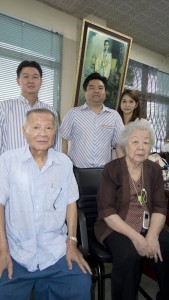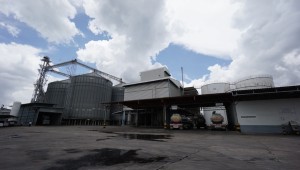With the goal of making a good location even better, PAS Export & Silos will build a new 4,000-tonne transit warehouse in Ayutthaya to improve logistic efficiency as it targets 15% sustained growth per annum.
Raw materials can be delivered to the plant via ship, truck and train, said Krit Pornamnuaysub, managing director. Whole soybeans can be shipped to Laem Chabang and then transferred to smaller boats that are towed to its warehouse in Ayutthaya or they can be trucked directly from Laem Chabang. However, transitioning cargoes from Laem Chabang and shipping them via barges on the Chaophraya River to Ayutthaya is more cost effective.
The new transit warehouse being built in Ayutthaya in Q3 this year will reduce both time spent on empty backhauls and overall travel distance. As a result, the average delivery cost for shipping products to customers in the upper north will be less than 0.30 baht/kg. In comparison, he estimates that it costs his competitors around 0.55-0.70 baht/kg to cover the same route.
Customers in the upper and lower north can be resupplied within 6-12 hours after placing orders. In the central region, the wait is 24 hours. At present, its delivery fleet has over 30 vehicles, including various types of trucks for shipping full-fat and regular soybean meal as well as tanker trucks for delivering refined and crude soybean oil.
Location – a game changer
At one time, Sawankhalok and Sukhothai were known as Thailand’s soybean belt. However, growing soybeans is no longer as profitable as rice, sugarcane or cassava. As a result, total soybean area has dipped from 480,000 hectares three decades ago to below 32,000 hectares.
With the locally produced soybean crop dwindling, PAS has opted to import rough grain to process. This strategy works mainly due to its ideal location, just a few hundred metres from Sawankhalok train stain.
Also, with a handful of the remaining soy growers still using local varieties, PAS is well positioned to deliver non-GMO products for customers in the food industry. This market is highly competitive, however, because there are only 60,000 tonnes of grain available each year.
Raw materials are only accepted if aflatoxins arebelow 45 ppb, fumonisin 0.5 ppb, trichothecene (T2) 25 ppb, and zearalenone 10 ppb. No detectable level of Salmonella is allowed.
The lower north location is its strongest market, mainly because it takes less than eight hours to deliver freshly milled products to customers in Chiang Rai, Nakhon Sawan, the Northeast and Central regions as well as Chachoengsao, Chonburi and more.
Freshness is critical. According to the Protein Research Foundation, digestible lysine in soybean meal decreases by 0.019% per month.
PAS clients are mainly farms and some feed mills that value the logistic convenience of having products delivered fresh, said Mr Krit. Avoiding foreign exchange rate risk is also a plus.
Customers can replenish stocks literally on a just-in-time (JIT) basis, he added.
PAS currently produces 800 tonnes of regular soybean meal/day, and 150 tonnes of full-fat soybean meal/day.
Soybean meal and vegetable oil processing
Kiatisak Patarapichit, plant manager, said soybeans are mainly imported from the US and some from Brazil and Argentina. Total imports amounted to 110,000 tonnes for fiscal year 2015. Of the total, US soybeans accounted for 80,000 tonnes and the rest came from Brazil and Argentina. The US supplies the largest share mainly because of logistical convenience, consistent supply and quality.
The soybeans are cleaned to remove dust and foreign materials. The cracking roller cracks the soybeans into 6-8 pieces. The hulls are removed because they absorb oil resulting in a lower yield.
The cracked beans are moved to a conditioning area where they are heated to make them soften and then fed to smooth, cylindrical rollers that press the particles into smooth, 0.3 mm thick flakes. The rolling process ruptures the oil cells, optimizing entry of hexane, a solvent used in the extraction process that seeps in and brings out the oil.
The solvent hexane is then evaporated from the solvent-oil mixture, also called “miscella”. The spent flakes are heated with steam to drive out hexane vapours which are captured and subsequently reused. At present, solvent loss in process is below 0.3 %.
The main products are spent flakes and crude soybean oil. The spent flakes are toasted to keep moisture below 13%, then cooled and packaged.
Heat treatment inactivates trypsin inhibitors. Therefore, the meal is medium cooked so that urease activity (UA) is 0.02-0.05 versus UA 0.015 of undercooked meal.
Undercooking the meal inhibits proteolytic enzyme activity and decreases digestive efficiency. On the other hand, overcooking it reduces lysine and cystine digestibility, decreasing the quality of the protein.
Therefore, medium-cooking the UA is important. At any rate, feed producers will process the meal further during conditioning and pelletizing, said Mr Kiattisak.
PAS soybean meal contains crude protein 44-45%, oil content 3%, protein solubility 73-85%, fiber 8%, ash 8%, and maximum aflatoxin limit 40 ppb/kg. The dehulled protein is 46-48%, fiber 7% and ash 7% with an aflatoxin limit of 20 ppb/kg.
Protein profile is tested for every batch and aflatoxin samples are regularly submitted for testing at a 3rd party lab, Mr Kiattisak added.
Soybean hulls are pelletized and sold to cattle farms. The pelletized hulls contain moisture content of 13.5%, urease activity 0.25, oil content 3%, crude protein 9%, fiber 32%, and aflatoxin below 20 ppb/kg. It currently produces around 4,000 tonnes/year.
The crude oil is further refined. The plant has a designed capacity of 200 tonnes/day. Lecithin, which is around 2-3% of the daily oil output obtained from the oil degumming process, is recombined with the meal.
PAS plans to raise the share of dehulled soybean that it markets to 30%, up from the current 10%, by 2017. It offers both crude and refined soybean oil. Demand for crude soybean oil is picking up among livestock customers.
Refinery operation
The crude degummed soybean oil undergoes neutralization, bleaching, and deodorization to remove off flavors, impurities and volatile compounds so that it becomes edible grade.
The refined oil is packed in 200-litre drums for tuna canneries and paint industry customers.
This segment accounts for 80% of turnover and the balance is packed in consumer-sized packages ranging from 1-litre, 1.9 and 5 litre polyethylene terephthalate (PET) bottles. Larger 13.75 and 18-litre sizes are packed in tins for food service users. It plans to further develop sales to retail and food service customers.
Full-fat soybean meal
The soybeans are cleaned to remove dust and foreign materials and then stored in buffer bins before processing. The beans are ground in a six tonne/hour hammer mill to reduce the particle size to 1.5 mm. After that, they are fed into a conditioner, temperature 60-70C, retention time one minute before going through a single-barrel extruder which churns out the full-fat meal.
The temperature at the extruder nozzle is 130-140C. The full-fat soybeans then go through a dryer and a cooler. After that, they are milled again by a 2nd hammer mill to break up clumps. The final particle size of between 1-1.5 mm is a result of the shearing action encountered in the system.
The extrusion process uses shear and pressure, which shatters cell walls to increase the availability of nutrients to animals. Due to the small particle size and direct contact with heat sources, the material is uniformly heat treated.
Full-fat soybean meal is a source of both protein and energy because it contains crude protein above 36% and fat above 18%.
Energy savings
Every possibility has been explored to reduce energy consumption. Presently, its crushing

standing from left) Krit, Krisda Pornamnuaysub and Piangpirm Raviampun (seated left) company founders Boonchai and Chawewan Pornamnuaysub
activity consumes only 45 kilowatts/tonne, but a 2%/year energy reduction target has been set. Also, carbon emissions are printed on the product label. Currently, producing a litre of soybean oil generates 1.54 kg of greenhouse gases.
The Pornamnuaysub family has been in the vegetable oil business for three decades, beginning with a crushing plant built in 1988 with a capacity of 200 tonnes/day. At present, it is Thailand’s 3rd largest producer, with 8% of the market.

